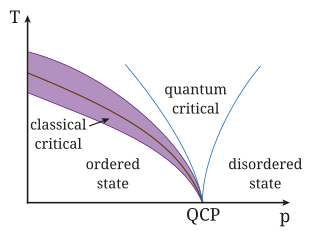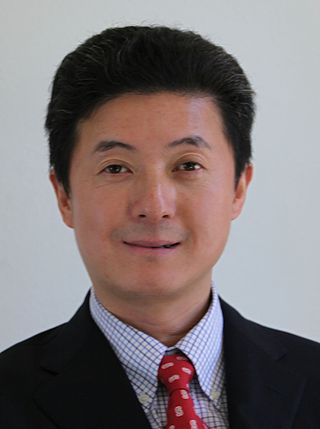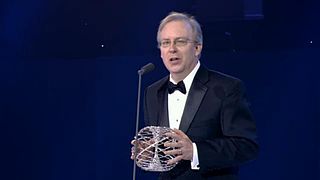
In physics, topological order is a kind of order in the zero-temperature phase of matter. Macroscopically, topological order is defined and described by robust ground state degeneracy and quantized non-Abelian geometric phases of degenerate ground states. Microscopically, topological orders correspond to patterns of long-range quantum entanglement. States with different topological orders cannot change into each other without a phase transition.

A Majorana fermion, also referred to as a Majorana particle, is a fermion that is its own antiparticle. They were hypothesised by Ettore Majorana in 1937. The term is sometimes used in opposition to a Dirac fermion, which describes fermions that are not their own antiparticles.

Xiao-Gang Wen is a Chinese-American physicist. He is a Cecil and Ida Green Professor of Physics at the Massachusetts Institute of Technology and Distinguished Visiting Research Chair at the Perimeter Institute for Theoretical Physics. His expertise is in condensed matter theory in strongly correlated electronic systems. In Oct. 2016, he was awarded the Oliver E. Buckley Condensed Matter Prize.

A topological insulator is a material whose interior behaves as an electrical insulator while its surface behaves as an electrical conductor, meaning that electrons can only move along the surface of the material.
The Rashba effect, also called Bychkov–Rashba effect, is a momentum-dependent splitting of spin bands in bulk crystals and low-dimensional condensed matter systems similar to the splitting of particles and anti-particles in the Dirac Hamiltonian. The splitting is a combined effect of spin–orbit interaction and asymmetry of the crystal potential, in particular in the direction perpendicular to the two-dimensional plane. This effect is named in honour of Emmanuel Rashba, who discovered it with Valentin I. Sheka in 1959 for three-dimensional systems and afterward with Yurii A. Bychkov in 1984 for two-dimensional systems.
Bismuth selenide is a gray compound of bismuth and selenium also known as bismuth(III) selenide.

Shoucheng Zhang was a Chinese-American physicist who was the JG Jackson and CJ Wood professor of physics at Stanford University. He was a condensed matter theorist known for his work on topological insulators, the quantum Hall effect, the quantum spin Hall effect, spintronics, and high-temperature superconductivity. According to the National Academy of Sciences:
He discovered a new state of matter called topological insulator in which electrons can conduct along the edge without dissipation, enabling a new generation of electronic devices with much lower power consumption. For this ground breaking work he received numerous international awards, including the Buckley Prize, the Dirac Medal and Prize, the Europhysics Prize, the Physics Frontiers Prize and the Benjamin Franklin Medal.
Symmetry-protected topological (SPT) order is a kind of order in zero-temperature quantum-mechanical states of matter that have a symmetry and a finite energy gap.

Charles L. Kane is a theoretical condensed matter physicist and is the Christopher H. Browne Distinguished Professor of Physics at the University of Pennsylvania. He completed a B.S. in physics at the University of Chicago in 1985 and his Ph.D. at Massachusetts Institute of Technology in 1989. Prior to joining the faculty at the University of Pennsylvania he was a postdoctoral associate at IBM's T. J. Watson Research Center working with his mentor Matthew P. A. Fisher, among others.
Weyl semimetals are semimetals or metals whose quasiparticle excitation is the Weyl fermion, a particle that played a crucial role in quantum field theory but has not been observed as a fundamental particle in vacuum. In these materials, electrons have a linear dispersion relation, making them a solid-state analogue of relativistic massless particles.

In physics, Dirac cones are features that occur in some electronic band structures that describe unusual electron transport properties of materials like graphene and topological insulators. In these materials, at energies near the Fermi level, the valence band and conduction band take the shape of the upper and lower halves of a conical surface, meeting at what are called Dirac points.
The term Dirac matter refers to a class of condensed matter systems which can be effectively described by the Dirac equation. Even though the Dirac equation itself was formulated for fermions, the quasi-particles present within Dirac matter can be of any statistics. As a consequence, Dirac matter can be distinguished in fermionic, bosonic or anyonic Dirac matter. Prominent examples of Dirac matter are graphene and other Dirac semimetals, topological insulators, Weyl semimetals, various high-temperature superconductors with -wave pairing and liquid helium-3. The effective theory of such systems is classified by a specific choice of the Dirac mass, the Dirac velocity, the gamma matrices and the space-time curvature. The universal treatment of the class of Dirac matter in terms of an effective theory leads to a common features with respect to the density of states, the heat capacity and impurity scattering.
In solid-state physics, the kagome metal or kagome magnet is a type of ferromagnetic quantum material. The atomic lattice in a kagome magnet has layered overlapping triangles and large hexagonal voids, akin to the kagome pattern in traditional Japanese basket-weaving. This geometry induces a flat electronic band structure with Dirac crossings, in which the low-energy electron dynamics correlate strongly.
Eugene John "Gene" Mele is a professor of physics at the University of Pennsylvania, where he researches quantum electric phenomena in condensed matter.
Magnetic topological insulators are three dimensional magnetic materials with a non-trivial topological index protected by a symmetry other than time-reversal. In contrast with a non-magnetic topological insulator, a magnetic topological insulator can have naturally gapped surface states as long as the quantizing symmetry is broken at the surface. These gapped surfaces exhibit a topologically protected half-quantized surface anomalous Hall conductivity perpendicular to the surface. The sign of the half-quantized surface anomalous Hall conductivity depends on the specific surface termination.
Photonic topological insulators are artificial electromagnetic materials that support topologically non-trivial, unidirectional states of light. Photonic topological phases are classical electromagnetic wave analogues of electronic topological phases studied in condensed matter physics. Similar to their electronic counterparts, they, can provide robust unidirectional channels for light propagation. The field that studies these phases of light is referred to as topological photonics.

The Rashba–Edelstein effect (REE) is a spintronics-related effect, consisting in the conversion of a bidimensional charge current into a spin accumulation. This effect is an intrinsic charge-to-spin conversion mechanism and it was predicted in 1990 by the scientist V.M. Edelstein. It has been demonstrated in 2013 and confirmed by several experimental evidences in the following years.
Bogdan Andrei Bernevig is a Romanian Quantum Condensed Matter Professor of Physics at Princeton University and the recipient of the John Simon Guggenheim Fellowship in 2017.
Fractional Chern insulators (FCIs) are lattice generalizations of the fractional quantum Hall effect that have been studied theoretically since early 2010. They were first predicted to exist in topological flat bands carrying Chern numbers. They can appear in topologically non-trivial band structures even in the absence of the large magnetic fields needed for the fractional quantum Hall effect. They promise physical realizations at lower magnetic fields, higher temperatures, and with shorter characteristic length scales compared to their continuum counterparts. FCIs were initially studied by adding electron-electron interactions to a fractionally filled Chern insulator, in one-body models where the Chern band is quasi-flat, at zero magnetic field. The FCIs exhibit a fractional quantized Hall conductance.
Bismuth-containing solid-state compounds pose an interest to both the physical inorganic chemists as well as condensed matter physicists due to the element's massive spin-orbit coupling, stabilization of lower oxidation states, and the inert pair effect. Additionally, the stabilization of the Bi in the +1 oxidation state gives rise to a plethora of subhalide compounds with interesting electronics and 3D structures.












